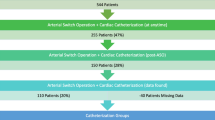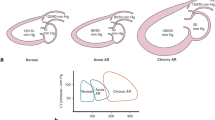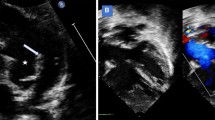Summary.
The development of aortic regurgitation (AI) is a rare but serious complication of subaortic ventricular septal defects (VSD). Over a period of 5 years we observed VSD-related AI in 24 patients, a frequency of 4.5% of all isolated VSD’s encountered during that time frame. The location of the defects was in the infundibular septum in 59%, it was perimembranous in 25% and in the trabecular septum in 16%. Hemodynamically the defects were small except for 2 where the Qp/Qs ratio was > 2.
Of the 24 pts, 16 had surgical closure of their VSD accompanied in 9 by aortic valvuloplasty. AI was caused by elongation or defect of the right coronary leaflet in 42%, of the noncoronary leaflet in 25% and a combination of both, in 8%. In 6 pts with infundibular VSD absence of part of the aortic valve ring above the defect was the underlying mechanism for AI. Postoperatively AI was improved to moderate in one pt and to none to trivial in 15. LV end-diastolic diameter decreased significantly in all pts operated.
Pathogenetic mechanisms for the development of AI are a deficiency in the aorto-infundibular junction with prolaps of the right—or non-coronary leaflet, deficiency of the valve supporting structures including the valve ring as well as suction of the already elongated leaflet into the VSD with further damage to the antiregurgitant mechanism of the semilunar valve at risk. In perimembranous VSD’s, late AI is probably related to turbulent flow through the adjacent LVOT.
Surgical closure of isolated VSD’s with a location immediately beneath the aortic valve is indicated regardless of their size to prevent the development of AI. If AI has occurred, VSD closure including aortic valvuloplasty improves the amount of regurgitation and normalizes LV enddiastolic dimension.
Zusammenfassung.
Das Auftreten einer zusätzlichen Aorteninsuffizienz (AI) ist eine schwerwiegende Komplikation der Ventrikelseptumdefekte (VSD), die wir in einem 5-Jahreszeitraum bei 24 Patienten (17 männlich, 7 weiblich) in einer Häufigkeit von 4,5% aller isolierter VSD’s beobachteten. Bei den VSD’s handelte es sich in 59% um infundibuläre VSD’s, in 25% um perimembranöse und in 16% um trabekuläre. Hämodynamisch waren die Defekte klein, nur 2 Patienten hatten ein Qp/Qs-Verhältnis > 2/1.
Bei 16 der 24 Patienten wurde der VSD operativ verschlossen, bei 9 gleichzeitig mit einer Valvuloplastik der Aortenklappe. Die AI war bei 42% der Patienten durch eine Elongation oder Defekt des rechtskoronaren aortalen Segels hervorgerufen, bei 25% des nonkoronaren Segels und bei 8% durch eine Kombination der beiden. Bei 6 Patienten mit infundibulärem VSD fehlte der Aortenklappenring teilweise. Postoperativ verbesserte sich die AI bei allen: bei einem Patienten von Grad 3 nach 2, alle anderen hatten keine oder nur eine minimale AI. Die Durchmesser des linken Ventrikels nahmen signifikant ab.
Pathogenetische Mechanismen der AI sind Substanzdefekte des aorto-infundibulären Überganges mit einem Prolaps des rechtes—oder non-koronaren Segels, ein Mangel der die Klappe unterstützenden Strukturen und ein Sog des bereits ausgeweiteten Segels in den VSD, der die Insuffizienz verstärkt. Bei perimembranösen Defekten ist eine späte AI durch einen turbulenten Fluss im linksventrikulären Ausfluss vorstellbar.
Bei infundibulären VSD’s ist ein chirurgischer Verschluss unabhängig von ihrer Größe zur Vorbeugung einer AI indiziert. Ist eine AI bereits aufgetreten, verbessert der chirurgische Verschluss in Verbindung mit einer Valvuloplastik die AI und normalisiert die linksventrikulären Diameter.
Similar content being viewed by others
Author information
Authors and Affiliations
Corresponding author
Additional information
Die Arbeit enthält wesentliche Ergebnisse der Dissertation M. Schaefer
Rights and permissions
About this article
Cite this article
Schmaltz, A.A., Schaefer, M., Hentrich, F. et al. Ventrikelseptumdefekt und Aorteninsuffizienz. Z Kardiol 93, 194–200 (2004). https://doi.org/10.1007/s00392-004-0015-2
Received:
Accepted:
Issue Date:
DOI: https://doi.org/10.1007/s00392-004-0015-2
Key words
- Ventricular septal defects
- aortic regurgitation
- frequency
- localization
- pathogenesis
- therapeutic consequences




